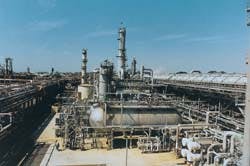Compressor-recycle valve design meets severe noise and operating specs
Paul A. Smirl, Herbert L. Miller
CCI
Rancho Santa Margarita, Calif.Helmut H. Dietz
Chevron U.S.A. Products Co.
El Segundo, Calif.
Chevron's El Segundo's alkylation unit is one of the largest in the world with a capacity of 26,500 b/d. The new 16 in. x 24 in. compressor recycle valve, located 40 ft above the ground, is on the bypass of a 15,000 hp refrigeration compressor.The design of the new compressor recycle valve at the Chevron El Segundo refinery's alkylation unit took into account four main considerations: noise, fugitive emissions, rapid stroking, and fire protection.
CCI, Rancho Santa Margarita, Calif., designed a 16 in. x 24 in. valve which met or exceeded design specifications. Since the valve went on-line on Nov. 15, 1996, the compressor recycle system has functioned without difficulty.
Fig. 1 [46,563 bytes] shows a schematic of the compressor recycle valve. The compressor inlet comes from a distillation column, and the compressor outlet goes to a reactor in the alkylation unit via several heat exchangers.
The alkylation unit processes a mixture of propylene and butylene to increase the octane rating of low-octane stock for gasoline blending.
Compressor recycle service
Regardless of design or application, all centrifugal compressors have one characteristic in common. At low capacities, orderly gas flow through the compressor is impossible because gas flows are too low to be converted to the required pressure in the discharge line.When compressor discharge pressure exceeds the impeller outlet pressure, backflow occurs until the compressor discharge pressure is less than the impeller outlet pressure. At this point, flow reversal again occurs, and the compressor operation becomes unstable, which results in excessive vibration and probable damage to the compressor itself.
This phenomenon is called stall and produces a surge in the system. The gas flow corresponding to this surge point is fixed at a constant speed, but changes at varying speeds (Fig. 2 [41,062 bytes]).
Valve purpose
Compressor recycle valves are used to recycle gas flow from the compressor discharge to the suction and prevent operation below the surge point.The valve protects the compressor from the destructive effects of low-capacity operation when the surges of flow reversal can actually destroy the compressor. Since unexpected low-capacity operation can occur quickly and without warning, the valve must be able to open quickly. The design of the full stroke operation of 20 in. (510 mm) was specified at 1.5 sec.
Table 1 [29,222 bytes] shows the required operating conditions of the new valve.
Noise
Because the valve is located adjacent to a large residential neighborhood, one strict design constraint for the compressor valve was maximum permissible noise level. Because the design required the new valve to be elevated about 40 ft (12 m) above the ground, noise control was more challenging.The new valve uses a multistage pressure-reduction design, which limits trim exit-velocity head to below 70 psi (480 kPa), to minimize noise and vibration. In pressure-reducing control valves for gas or steam application, velocity head (rv2/2, where r is density and v is velocity) rather than pure velocity is the accepted design criteria.
Fig. 3 [89,928 bytes] shows the sectional view of the large compressor recycle valve. Two design elements of the trim are important.
First, the pressure-reducing element itself is made of a stack of tortuous path disks having multiple right-angle turns (Fig. 4 [104,534 bytes]). This stack of disks surrounds the plug throughout its stroke. Also, the disk stack incorporates a pressure-equalizing ring (PER) on the inside diameter to ensure equal pressure acting radially on the valve plug at all times; this feature eliminates vibration that could occur as a result of rapid plug radial movement.
Second, relatively low differential pressures permit the use of a soft extruded Teflon seat, which ensures nearly zero leakage when the valve is closed, exceeding the requirements of leakage specified by ANSI (American National Standards Institute). This seat design also permits the use of a smaller actuator, which increases actuator stroking speed.
The recycle valve was designed for less than 85 dbA and has functioned better than this since start-up.
Fugitive emissions
The valve had to meet all current and possible future fugitive emissions requirements for valve stems. To comply, the compressor recycle valve is fitted with a special inert packing system. This system is made of alternate chevron-shaped rings of fluorocarbon material and fluoroelastomer material plus a flexible graphite ring for fire safety.The packing system is rated for a maximum-continuous-use temperature of 500° F. (260° C.) and has successfully passed the API 607, Third Edition, fire test. The packing also decreased fugitive emissions in volatile organic compounds (VOCs) to levels far below those required by current local, state, and federal regulations, in particular, the Clean Air Act. The leakage has been tested to less than 5 ppm.
Rapid stroking
Because very rapid flow changes can occur in the compressor output, the recycle valve has to be capable of reacting quickly. To accomplish this, the pneumatic actuator's 20 in. stroke was undamped, and multiple boosters and exhausters were provided on the top and the bottom of the actuator to move the air in and out very quickly. In service, the stroke only took 1.3 sec, exceeding the specified 1.5 sec stroking time. The control system is shown in Fig. 5 [89,745 bytes].Fire protection
Fire protection was provided to ensure reliable operation during a hydrocarbon fire environment. The pneumatic actuator and its control system are completely encased in a fire protection blanket. Fig. 6 [86,589 bytes] shows the blanket location.During a fire, the fire blanket protects the valve from heat by the expansion of chemically inert, high temperature insulation fibers, which tightly seals all air gaps and reduces heat penetration of the protective envelope.
The Authors
Paul Smirl is manager of advanced products at CCI. He has served more than 13 years in the process control industry and has 10 years of experience with severe-service control valves. He attended Texas Tech University, Lubbock.
Herbert L. Miller is vice-president of operations of CCI. He has been involved with the design, manufacture, and application of control valves for severe service for more than 20 years. He holds a BS degree in mechanical engineering from Ohio Northern University, Ada, and an MS degreee in mechanical engineering from Northwestern University, Evanston, Ill.
Helmut Dietz is an instrument and electrical (I&E) supervisor in the capital projects group, Chevron U.S.A. Products Co., at the El Segundo, Calif., refinery. He is responsible for instrument and electrical quality assurance and compliance during the design and construction of projects. He was I&E construction supervisor for the alkylation project. He has 17 years of experience in I&E design, construction, and maintenance
Copyright 1997 Oil & Gas Journal. All Rights Reserved.




